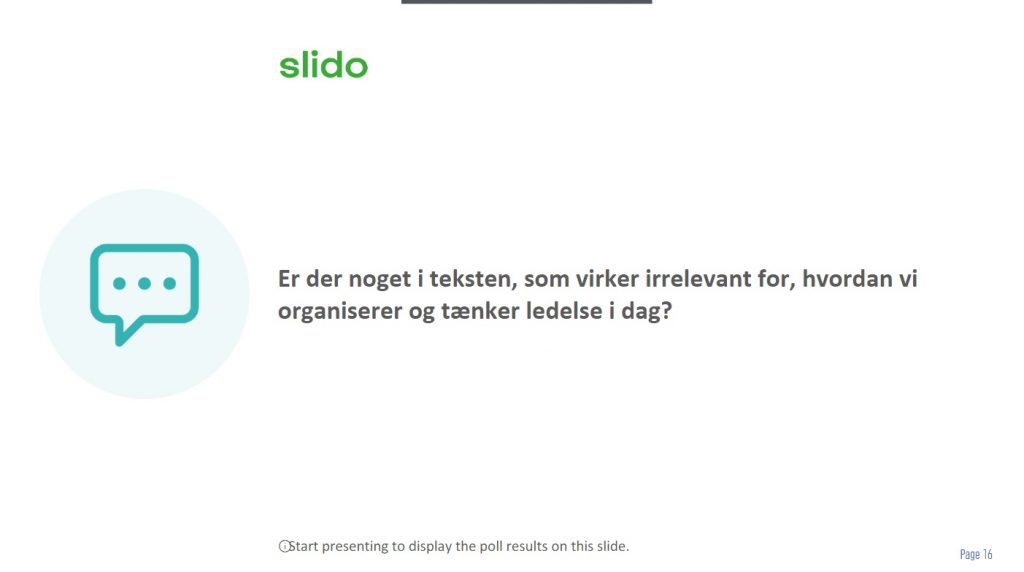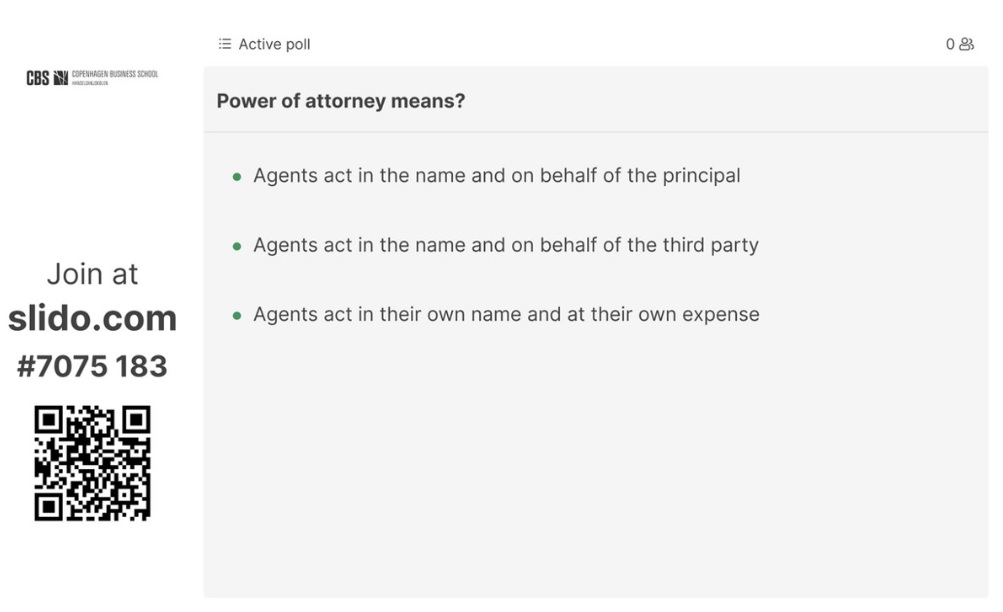EMPOWERING EDUCATORS AT
COPENHAGEN BUSINESS SCHOOL
COPENHAGEN BUSINESS SCHOOL

It has already been two years since we implemented Slido in our tool suite. At this time, 200 educators across CBS are currently using Slido. Our faculty has witnessed firsthand how Slido can transform passive lectures into dynamic, interactive sessions, significantly enhancing student participation and comprehension through its diverse interactive features. In this blog post, we share some examples from CBS educators who have successfully integrated Slido into their teaching in a large classroom setting.
Karen Boll, Professor from the department of Organization (IOA), has started using Slido to bring more voices into the classroom. One of the ways she’s doing it is by using Slido’s open-ended questions, and gathering insights from her students. This approach allows her to facilitate a broader discussion but also to identify and address misconceptions.
For instance, she challenges her students to reflect on the contemporary relevance of theories, asking questions like “Is there anything in Gulick’s text that seems irrelevant today?” and thereby asks them to discuss in pairs before they submit their thoughts on Slido. In this way, the students are called to engage in meaningful discussions with their peers and develop critical thinking.

In a large class setting, managing the influx of student responses is challenging. That is why sometimes she reviews the answers post-class, identifying patterns and misconceptions, which she then addresses in subsequent lectures. This method ensures that every student’s voice is considered in shaping the course content. “It’s about understanding their thought process and guiding them,” Karen says, highlighting the importance of this feedback loop in enhancing the learning experience.
Sara Maria Denta, from the Department of Business Humanities and Law, has significantly transformed her teaching approach with Slido’s live polling feature. Reflecting on her experience, she shares, “Before I felt like I was talking to a dead auditorium, now I feel a much greater interaction with the students.” This change has turned her lectures into vibrant, interactive sessions, breaking away from the monotony of one-way communication.
Her use of Slido has not only enhanced classroom dynamics but also improved her teaching methods. As Sara Maria observes, “It has made my teaching better, as I have become more aware of where I should emphasize my teaching.” Live polling has given her valuable insights into where students struggle, allowing her to adapt her lectures for better comprehension and engagement.

In another instance of personalized teaching, Karen asks her students to share challenges they have faced in organizational roles. She then integrates these experiences into her lectures, ensuring the content resonates more deeply with her students.
Pedro Monteira, from IOA shares how he also uses Slido as a feedback mechanism to improve his course. In his words, “I used Slido at some moments in the course to elicit feedback on the course itself. I used to do it by distributing post-its and asking students to write what they felt was working, what needed a change”.
Gathering feedback via Slido is easy using the “survey tool” as you can combine several different types of questions and then Slido shows you the result in a visually meaningful way.
“The students are very reticent to speak up. This last cohort, in particular, seemed anxious about their peers’ reactions. I usually do a survey at the start of the course to check expectations, and many mentioned that they feared being shamed by their peers and hoped for respect in the classroom” reflects Pedro. His solution to encourage all students to ask questions has been the Q&A feature of Slido, where students can ask questions.
Pedro also notes a potential downside to Slido, pointing out the possibility of misuse: “The only downside of Slido is that there is space for negative behavior, like any communication media.” He recounts an episode where a student played a prank during a lecture, writing a misleading message on Slido. Despite this minor setback, Pedro maintains that the overall benefits of using Slido significantly outweigh such incidents and started to incorporate a note on etiquette in the first lesson.
Complementing Pedro’s approach, Karen Boll leverages the Q&A feature of Slido in a different context. She primarily uses it during the final sessions of her courses, especially to address questions related to the final exam. In her large classes, this method proves highly efficient for crowdsourcing student inquiries and addressing them systematically.
Pedro Monteiro’s flipped classroom model introduces another dimension of gamification. By beginning his lectures with a competitive quiz via Slido, Pedro taps into the inherent competitive spirit of his students, especially effective in engaging students who thrive in challenge-based environments. This not only serves as a recap of their pre-class preparations but also makes learning an active and enjoyable pursuit.
Interested in incorporating Slido into your teaching? Get started by visiting this page or contacting Mads Szylit Larsen at msl.tl@cbs.dk to get a license. Once you have it, go to slido.com and sign in with your CBS login.